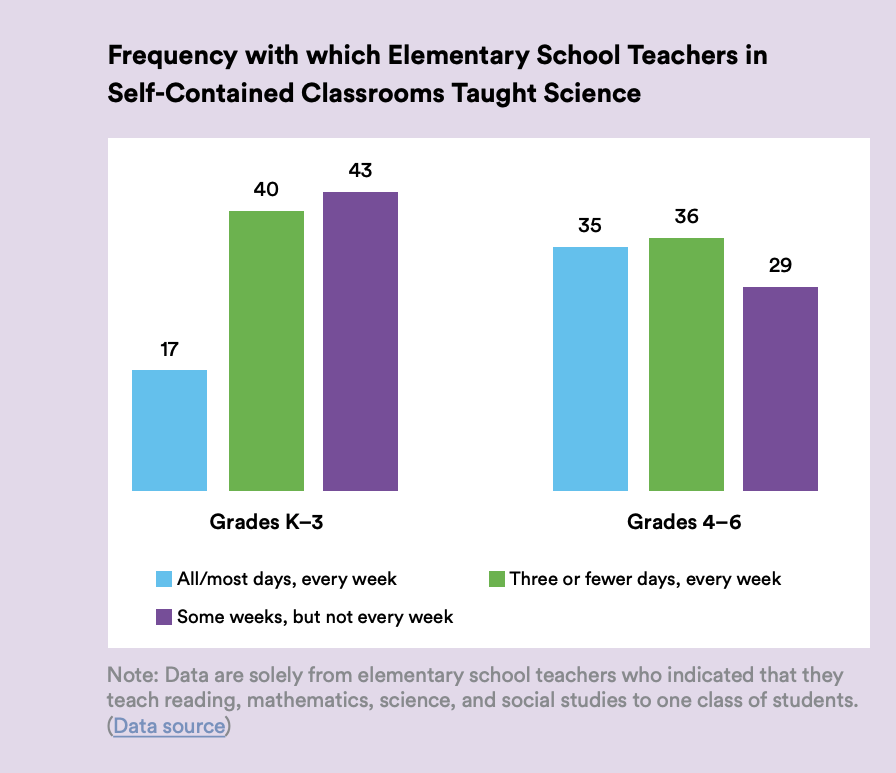Posted in: Aha! Blog > PhD Science > Science OER > Science Should Not Be an Elementary School Elective: White Paper
Science education is consistently squeezed out of elementary school schedules. Distance and hybrid learning further threatens the time allocated to science instruction as it is too easy to minimize science instruction in a condensed schedule or believe science is too challenging to teach outside the classroom. The research, however, is clear: Students need science education through a high-quality curriculum in the early years.
Indeed, science instruction can, and must, be delivered in elementary school regardless of where learning takes place. That’s why Great Minds® adapted PhD Science®, its existing print science curriculum for Levels K–5, to create PhD Science in Sync®, a hybrid curriculum for learning in any environment. Additionally, Great Minds is pleased to release its full Levels K–2 curriculum as an open educational resource.
Time is a scarce resource in elementary science instruction.
 Even when schools are open and operating under normal circumstances, science perpetually receives less time and attention as a core academic subject than English language arts or mathematics. A 2018 study from Horizon Research Inc. found that in Grades K–3, science was being taught for 18 minutes per day on average compared to 89 minutes for English language arts and 57 minutes for mathematics. In Grades 4–6, science instructional time fares only slightly better.
Even when schools are open and operating under normal circumstances, science perpetually receives less time and attention as a core academic subject than English language arts or mathematics. A 2018 study from Horizon Research Inc. found that in Grades K–3, science was being taught for 18 minutes per day on average compared to 89 minutes for English language arts and 57 minutes for mathematics. In Grades 4–6, science instructional time fares only slightly better.
While the Horizon report averaged the time allocations per day, the reality is that most students are not even receiving science instruction every week. In fact, data from the same report show that nearly half of teachers in Grades K–3 are teaching science “some weeks, but not every week.” The data improve, both in terms of minutes allocated and days allocated to science instruction in Grades 4–6. While the research does not offer a suggestion as to why, one could wonder if science assessments in upper elementary school or middle school, or less time spent on reading/ language arts in upper elementary grades, creates more time for science instruction. However, the reality remains that science is taught less frequently than English language arts and mathematics in many elementary school classrooms.
 Unfortunately, the time allocated to science instruction is not distributed evenly across schools and districts, thus furthering inequities in science for students. In its 2012 A Framework for K–12 Science Education, the National Research Council highlighted that “in schools serving the most academically at-risk students, there is today an almost total absence of science in the early elementary grades.… This state of affairs is ironic in that students in the early elementary school grades are often deeply attracted to topics related to the natural and designed worlds—interests that provide a foundation for learning science. Furthermore, for students with limited language skills, the absence of opportunities to engage in science learning deprives them of a rich opportunity for language development that goes beyond basic vocabulary.”
Unfortunately, the time allocated to science instruction is not distributed evenly across schools and districts, thus furthering inequities in science for students. In its 2012 A Framework for K–12 Science Education, the National Research Council highlighted that “in schools serving the most academically at-risk students, there is today an almost total absence of science in the early elementary grades.… This state of affairs is ironic in that students in the early elementary school grades are often deeply attracted to topics related to the natural and designed worlds—interests that provide a foundation for learning science. Furthermore, for students with limited language skills, the absence of opportunities to engage in science learning deprives them of a rich opportunity for language development that goes beyond basic vocabulary.”
All elementary students need more science instruction, but especially those in the early grades. By creating time for this instruction, schools give students the opportunity to scaffold their future learning and build knowledge gradually rather than entering more intensive science classes in middle school with little to no prior science knowledge to draw on. A strong, knowledge-building science curriculum in the early grades not only starts the knowledge-building process early but also engages students when they are at their most curious. If students do not encounter meaningful science instruction until middle school, their interest may wane.
In addition, an investment in science instruction is an investment in helping students build knowledge of other subjects. Science does not exist in a vacuum; English language arts and mathematics are intertwined with it. In fact, in a report based on a review of 150 empirical studies, the Bay Area Discovery Museum found that “as children engage in STEM experiences, they hear and practice new words. Growing vocabularies allow children to make sense of increasingly complex ideas and phenomena, and early exposure to vocabulary used for concepts can support children later on to master higher order thinking.” Research also shows a positive relationship between students’ background knowledge and reading comprehension.
PhD Science is intentional in its approach to building knowledge and vocabulary to help students make meaningful connections between vocabulary words and experiences. Rather than start with a vocabulary word or terminology, PhD Science first introduces an activity so all students have the same starting point to access the concept being taught, and once the concept is taught, terminology follows. Because the introduction of the terminology happens last, students have the opportunity to experience the concept which helps create the necessary background knowledge to attach meaning to the terminology and build enduring knowledge. Investing in students’ science education in elementary school provides them the opportunity to grow their vocabularies to include science concepts early, which will serve them well as they continue on to higher-level science courses and more sophisticated concepts.
Acknowledging the reality that time allocated to science instruction in elementary school will continue to be significantly less than for mathematics and ELA, PhD Science is designed for science instruction to occur about three to five times per week with 35-minute lessons in Levels K–2 and 45-minute lessons in Levels 3–5. Investing this time in high-quality science instruction not only increases students’ science knowledge and exposure, but it also helps students build cross-disciplinary knowledge and connections. PhD Science is designed to seamlessly integrate with English language arts and mathematics instruction. The Teacher Edition of PhD Science outlines connections to math, history, art, and English language arts. Further, every module includes one or more trade books that support the science while allowing students to practice their literacy skills.
Time must be used intentionally for maximum coherence.
Creating time for science instruction in the early grades is the first step to ensuring students receive a high-quality science education. Providing a coherent, knowledge-building curriculum is the second step. Too often, science instruction in the earliest grades consists of disparate activities rather than the comprehensive, coherent instruction called for in A Framework for K–12 Science Education and the Next Generation Science Standards (NGSS).
In “Taking Science to School: Learning and Teaching Science in Grades K–8,” the Committee on Science Learning, Kindergarten through Eighth Grade of the National Research Council argues that “to be successful in science, students need carefully structured experiences, instructional support from teachers, and opportunities for sustained engagement with the same set of ideas over weeks, months, and even years.”
Throughout their K–12 education, students should revisit core science concepts to build knowledge, make meaningful connections across scientific concepts and to other disciplines, and develop a foundational understanding of science. In PhD Science, students explore and revisit core concepts such as matter and its interactions, heredity, and Earth systems.
In science education, a coherent, high-quality curriculum is critical because, as researchers in the 2019 study “Early Elementary Science Instruction: Does More Time on Science or Science Topics/Skills Predict Science Achievement in the Early Grades?” found, “simply allocating more time to science instruction or altering the depth/breadth of science instruction by changing the number of science topics or skills covered in the early elementary classroom does not appear to be a high-leverage means of improving science outcomes.” The researchers go on to state that “it is possible that the impacts of time on science and depth of coverage are limited by a lack of use of effective science instructional practices or a lack of resources and supports to facilitate such practices.”
Using a knowledge-building curriculum in the early grades has educational benefits that extend well beyond science. Research by the Education Commission of the States has found that “early mathematics skills and general knowledge in science and social studies might be even more important for school achievement, not just in math and science but in reading as well. Knowledge of the natural and social worlds seems to be more predictive of reading achievement than are early reading skills.” The cross-content connections in PhD Science are specifically designed to support and reinforce students’ English language arts and mathematics learning.
Waiting until the upper grades to start science in earnest can often be frustrating for students since they lack strong background knowledge and, moreover, science instruction in later grades often relies on dull textbooks and memorization tasks. PhD Science is different. Its hands-on, student-driven learning model and focus on examining real-world phenomena spark students’ curiosity and provide them with the opportunity to build knowledge comprehensively.
PhD Science is explicitly structured to help students build on their learning and deepen their understanding of increasingly complex concepts. For example, matter is introduced in Level 2 to help students begin building an understanding of the concept. Level 5 then revisits the topic, introducing more complex types of matter—for example, invisible gases—and their impact on the world. Since students explored the properties of matter in Level 2, they have more knowledge to bring to the conversation in Level 5, when the learning moves from concrete to abstract.
Early high-quality science instruction is key to increasing STEM diversity.
Instructional equity must be a priority. Even before the pandemic, we knew that instructional time was not provided equitably to all schools and students, nor were the quality of instructional materials and their distribution equitable among all schools. We also know that few underrepresented students pursue careers in science, technology, engineering, or math (STEM) and that this leaky pipeline is partly due to a lack of a high-quality curriculum throughout those students’ schooling.
A 2018 report from the Pew Research Center found that people working in STEM careers believe that Black and Hispanic individuals are underrepresented because of limited educational opportunities, with “52 percent of those with a STEM job saying a major reason for this underrepresentation is because blacks and Hispanics are less likely to have access to a quality education that prepares them for these fields, while 45 percent attribute these disparities to these groups not being encouraged at an early age to pursue STEM-related subjects.” One way to address these problems is to begin science instruction earlier for all students. In “The Disconnect between Minority Students and STEM Careers,” the American Institutes for Research argues that “research shows that engaging students, particularly minority students, in STEM education early in the elementary school years makes a difference in students’ achievement and their intent to major in STEM.”
By focusing on science education for young students, schools can start to reverse this trend of underrepresentation in STEM careers and engage students in STEM when their natural curiosity and interest are high. A 2017 report from The Joan Ganz Cooney Center at Sesame Workshop found that the research is clear that “children who engage in scientific activities from an early age develop positive attitudes toward science, which also correlate with later science achievement, and they are more likely to pursue STEM expertise and careers later on.” While it may be challenging to take on a new curriculum in the midst of the current teaching and learning environment, schools and educators must do so to help all students develop a passion for and a deep knowledge of science that will support them as they move through later grades and put them on a trajectory to STEM careers.
Since some students may not have much background knowledge in science, PhD Science offers multiple points of entry to a module so that all students can contribute to the discussion. For example, fine art is a key component of PhD Science. The chosen works of art provide students with a window into the anchor phenomenon of the module and an opportunity to transfer their knowledge to unexpected contexts. Students of all skill levels and backgrounds can observe fine art; they share what they notice and wonder about the work, which prepares them to ask questions and make observations throughout the science lesson. Providing students multiple points of entry to the content helps them feel included and makes science more accessible.
Great Minds provides support to prioritize science instruction in any learning environment.
As schools adjust to a new school year with continued variability in the learning environment, high-quality, content-rich, coherent science instruction must find its place in the instructional schedule or else students will miss out on valuable learning and engagement in science.
To support schools and districts in keeping science at the forefront of elementary education, Great Minds is pleased to offer PhD Science and PhD Science in Sync for Levels K–5. PhD Science in Sync is a complementary educational program to PhD Science, designed with hybrid learning in mind. The flexible lessons can be completed with pencil and paper, online, or in a blended online-offline model (recommended).
There are several ways schools can engage with PhD Science for Levels K–5. Schools can pilot in-class curriculum. Also, all modules of PhD Science are available for hybrid learning so that schools can engage in distance or hybrid learning. The core curriculum files for PhD Science for Levels K–2 are available to download for free as an open educational resource.
Now is not the time to dismiss science instruction as too hard to deliver in a distance or hybrid environment. Nor is it the time to delay implementing a rigorous, knowledge-building science curriculum in elementary school. Great Minds remains committed to ensuring that all students, regardless of learning environment, have access to high-quality, knowledge-building science instruction throughout elementary school.
American Institutes for Research. 2014. The Disconnect between Minority Students and STEM Careers. American Institutes for Research. https://www.air.org/resource/blog-post/disconnect-between-minority-students-and-stem-careers
Association for Psychological Science. 2019. A Lack of Background Knowledge Can Hinder Reading Comprehension. Association for Psychological Science. https://www.psychologicalscience.org/news/releases/knowledge-reading-comprehension.html.
Committee on Science Learning, Kindergarten through Eighth Grade. 2007. Taking Science to School: Learning and Teaching Science in Grades K–8. Edited by Richard A. Duschl, Heidi A. Schweingruber, and Andrew W. Shouse. National Academies Press. https://www.nsf.gov/attachments/117803/public/2c--Taking_Science_to_School.pdf.
Curran, F. Chris and James Kitchin. 2019. Early Elementary Science Instruction: Does More Time on Science or Science Topics/Skills Predict Science Achievement in the Early Grades? American Educational Research Association Open. https://journals.sagepub.com/doi/10.1177/2332858419861081#.
Education Commission of the States. 2014. The Progress of Education Reform: Science in the Early Years. Education Commission of the States. https://eric.ed.gov/?id=ED560994
Funk, Cary and Kim Parker. 2018. Women and Men in STEM Often at Odds over Workplace Equity: 4. Blacks in STEM Jobs Are Especially Concerned about Diversity and Discrimination in the Workplace. Pew Research Center: Social & Demographic Trends. https://www.pewsocialtrends.org/2018/01/09/blacks-in-stem-jobs-are-especially-concerned-about-diversity-and-discrimination-in-the-workplace.
Hadani, Helen Shwe and Elizabeth Rood. 2018. The Roots of STEM Success: Changing Early Learning Experiences to Build Lifelong Thinking Skills. Bay Area Discovery Museum. https://bayareadiscoverymuseum.org/roots-stem-success.
McClure, E. R., Guernsey, L., Clements, D. H., Bales, S. N., Nichols, J., Kendall-Taylor, N., and Levine, M. H. 2017. STEM Starts Early: Grounding Science, Technology, Engineering, and Math Education in Early Childhood. New York: The Joan Ganz Cooney Center at Sesame Workshop. http://joanganzcooneycenter.org/wp-content/uploads/2017/01/jgcc_stemstartsearly_final.pdf.
National Research Council. 2012. A Framework for K–12 Science Education: Practices, Crosscutting Concepts, and Core Ideas. The National Academies Press. https://www.nap.edu/catalog/13165/aframework-for-k-12-science-education-practices-crosscutting-concepts.
Smith, P. Sean. 2020. 2018 NSSME+: Trends in US Science Education from 2012 to 2018. Horizon Research Inc. https://files.eric.ed.gov/fulltext/ED611301.pdf
Download the Article as a Free PDF

Jenny Taylor
Jenny has over a decade of experience in education policy and research. She has worked with states and districts on the development and implementation of college and career readiness policies, especially around the implementation of rigorous standards and high-quality instructional materials. She has extensive knowledge about K–12 standards, graduation requirements, assessments, and accountability systems nationwide. Additionally, she has conducted research for school districts to address pressing needs in those districts. Jenny received her B.A. in English and education from Bucknell University and her M.Ed. in education policy from the University of Pennsylvania Graduate School of Education.











